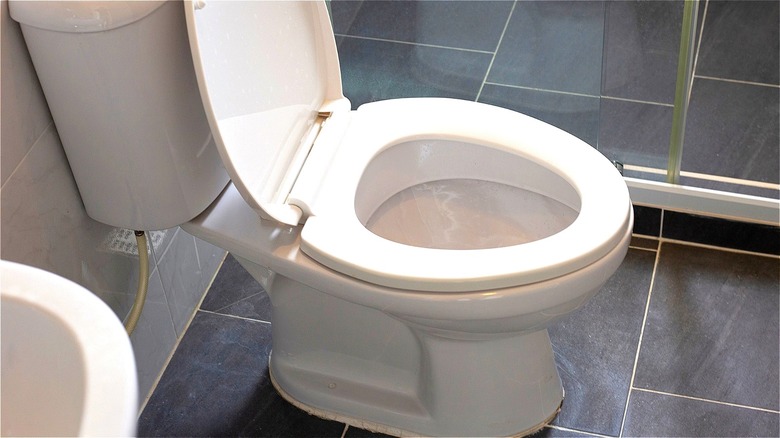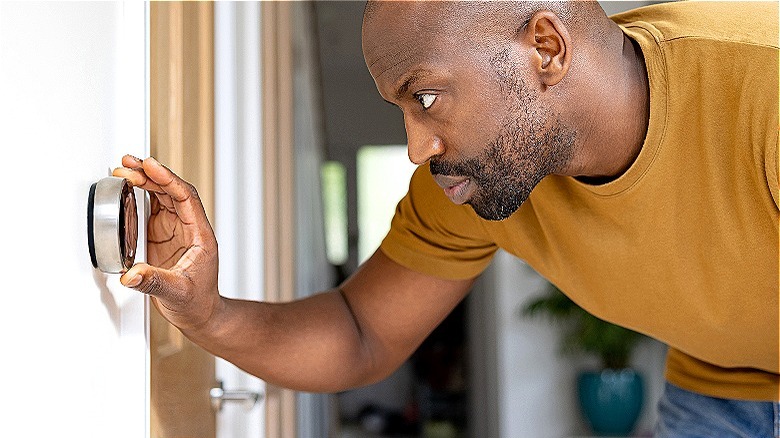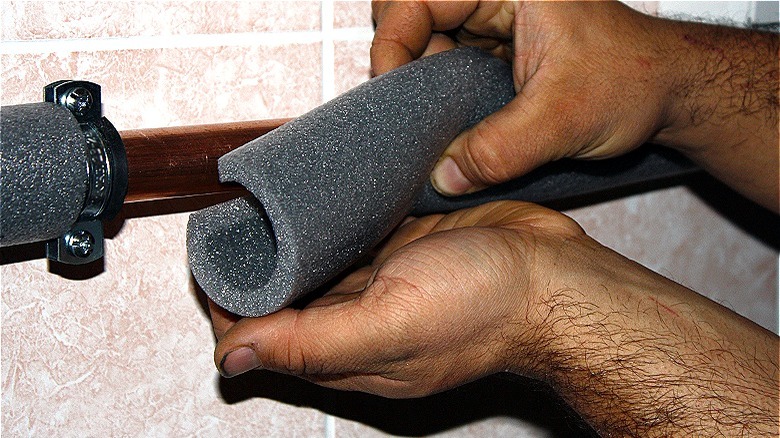What To Do If Your Toilet Pipes Freeze Up During The Winter
When toilet pipes freeze, they can cause nightmarish problems for the home, from damaging leaks to cracked porcelain. But, if you find your toilet pipes have frozen over this winter, know you have a few ways to try and remedy the situation. In short, you're going to want to thaw out your frozen toilet pipes before they lead to a disaster. Among the DIY approaches you can try include using hot water, a hair dryer, a space heater, heating pads, hot towels, and heat tape.
Though your house may be heated during the winter, plumbing inside exterior walls is more likely to freeze on cold, frigid days. Pipes that run through unheated areas of your home, like basements, garages, and attics, are also more susceptible to freezing. For toilets with frozen drain pipes, it's crucial not to use the toilet until the pipe has had a chance to thaw. If you're certain the supply line is the frozen pipe, however, the toilet is still usable, but will need to be flushed by dumping a bucket of water into the bowl. To prevent frozen pipes in the future, insulation, heating cables, and Plumber's antifreeze are great options.
How to unfreeze toilet pipes
During the winter, if your toilet tank stops refilling like normal, it's quite possible it's due to a frozen pipeline, which you can try thawing with hot water. To start, fill a bucket with hot water — but not boiling water as this could crack your toilet bowl or damage PVC pipes. Next, slowly pour the hot water into the toilet bowl and flush the toilet to help the water move down the frozen line.
Note that while hot water can help with frozen drain lines, it won't unfreeze the toilet's supply line. In such cases, if the frozen pipes in question are behind walls and indeed inaccessible, you could try increasing the temperature inside the home. This solution will take some time, but turning up your thermostat is a simple way to thaw pipes out wherever they may be. As for the setting, try 75 to 80 degrees Fahrenheit for a few hours.
If the toilet pipe is visible, however, and you can confirm it's frozen by touch, you have a few other options. All involve applying heat to the frozen toilet pipe and slowly thawing it out. For example, you could try directing air from a low-setting hair dryer onto the frozen pipe or placing a space heater near it. Note, a space heater is most effective in small bathrooms but could pose a fire risk, so monitor the thawing process. Wrapping the pipe(s) in hot towels, a heating pad, or heat tape is another good option to try before calling in a plumber.
Preventing frozen toilet pipes
To keep pipes from freezing during winter, adding extra insulation near your toilet pipes will help protect them from colder conditions. Regular foam insulation can be wrapped around the pipe and secured with heat-resistant tape, or you could try insulation wraps that are made to easily slide over pipes. If you have toilet pipes that seem prone to freezing, heating cables can help. Wrap the cables around your pipes, plug them into an outlet, and they'll automatically begin warming the pipes as temperatures drop.
If you're planning to leave your home for a while this winter, make sure to keep your heater running. This will help to prevent pipes from freezing, but Plumber's antifreeze could also be used to give your toilet extra protection. For this method, you'll need to shut off the water to your toilet, flush it to drain any remaining water, and pour the antifreeze into the empty tank. When you return and turn the water back on, flushing the toilet will get rid of the chemicals. If you're unable to thaw a frozen toilet pipe on your own or if the pipe bursts, it's best to call a professional plumber.


